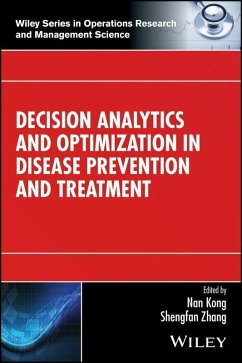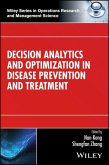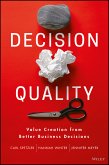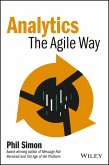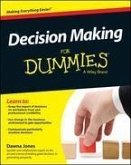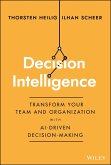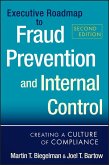Decision Analytics and Optimization in Disease Prevention and Treatment (eBook, PDF)
Redaktion: Kong, Nan; Zhang, Shengfan


Alle Infos zum eBook verschenken

Decision Analytics and Optimization in Disease Prevention and Treatment (eBook, PDF)
Redaktion: Kong, Nan; Zhang, Shengfan
- Format: PDF
- Merkliste
- Auf die Merkliste
- Bewerten Bewerten
- Teilen
- Produkt teilen
- Produkterinnerung
- Produkterinnerung

Hier können Sie sich einloggen

Bitte loggen Sie sich zunächst in Ihr Kundenkonto ein oder registrieren Sie sich bei bücher.de, um das eBook-Abo tolino select nutzen zu können.
A systematic review of the most current decision models and techniques for disease prevention and treatment Decision Analytics and Optimization in Disease Prevention and Treatment offers a comprehensive resource of the most current decision models and techniques for disease prevention and treatment. With contributions from leading experts in the field, this important resource presents information on the optimization of chronic disease prevention, infectious disease control and prevention, and disease treatment and treatment technology. Designed to be accessible, in each chapter the text…mehr
- Geräte: PC
- mit Kopierschutz
- eBook Hilfe
- Größe: 6.73MB
![Decision Analytics and Optimization in Disease Prevention and Treatment (eBook, ePUB) Decision Analytics and Optimization in Disease Prevention and Treatment (eBook, ePUB)]() Decision Analytics and Optimization in Disease Prevention and Treatment (eBook, ePUB)100,99 €
Decision Analytics and Optimization in Disease Prevention and Treatment (eBook, ePUB)100,99 €![Heuristics in Analytics (eBook, PDF) Heuristics in Analytics (eBook, PDF)]() Carlos Andre Reis PinheiroHeuristics in Analytics (eBook, PDF)32,99 €
Carlos Andre Reis PinheiroHeuristics in Analytics (eBook, PDF)32,99 €![Decision Quality (eBook, PDF) Decision Quality (eBook, PDF)]() Carl SpetzlerDecision Quality (eBook, PDF)20,99 €
Carl SpetzlerDecision Quality (eBook, PDF)20,99 €![Analytics (eBook, PDF) Analytics (eBook, PDF)]() Phil SimonAnalytics (eBook, PDF)32,99 €
Phil SimonAnalytics (eBook, PDF)32,99 €![Decision Making For Dummies (eBook, PDF) Decision Making For Dummies (eBook, PDF)]() Dawna JonesDecision Making For Dummies (eBook, PDF)18,99 €
Dawna JonesDecision Making For Dummies (eBook, PDF)18,99 €![Decision Intelligence (eBook, PDF) Decision Intelligence (eBook, PDF)]() Thorsten HeiligDecision Intelligence (eBook, PDF)20,99 €
Thorsten HeiligDecision Intelligence (eBook, PDF)20,99 €![Executive Roadmap to Fraud Prevention and Internal Control (eBook, PDF) Executive Roadmap to Fraud Prevention and Internal Control (eBook, PDF)]() Martin T. BiegelmanExecutive Roadmap to Fraud Prevention and Internal Control (eBook, PDF)28,99 €
Martin T. BiegelmanExecutive Roadmap to Fraud Prevention and Internal Control (eBook, PDF)28,99 €-
-
-
Dieser Download kann aus rechtlichen Gründen nur mit Rechnungsadresse in A, B, BG, CY, CZ, D, DK, EW, E, FIN, F, GR, HR, H, IRL, I, LT, L, LR, M, NL, PL, P, R, S, SLO, SK ausgeliefert werden.
- Produktdetails
- Verlag: John Wiley & Sons
- Seitenzahl: 432
- Erscheinungstermin: 2. Februar 2018
- Englisch
- ISBN-13: 9781118960134
- Artikelnr.: 54242295
- Verlag: John Wiley & Sons
- Seitenzahl: 432
- Erscheinungstermin: 2. Februar 2018
- Englisch
- ISBN-13: 9781118960134
- Artikelnr.: 54242295
- Herstellerkennzeichnung Die Herstellerinformationen sind derzeit nicht verfügbar.
chuan Suen 1.1 Tuberculosis Epidemiology and Background 4 1.1.1 TB in India 5 1.2 Microsimulations for Disease Control 6 1.3 A Microsimulation for Tuberculosis Control in India 8 1.3.1 Population Dynamics 9 1.3.2 Dynamics of TB in India 9 1.3.3 Activation 10 1.3.4 TB Treatment 11 1.3.5 Probability Conversions 13 1.3.6 Calibration and Validation 14 1.3.7 Intervention Policies and Analysis 16 1.3.8 Time Horizons and Discounting 18 1.3.9 Incremental Cost
Effectiveness Ratios and Net Monetary Benefits 19 1.3.10 Sensitivity Analysis 22 1.4 Conclusion 22 References 23 2 Saving Lives with Operations Research: Models to Improve HIV Resource Allocation 25 Sabina S. Alistar and Margaret L. Brandeau 2.1 Introduction 25 2.1.1 Background 25 2.1.2 Modeling Approaches 27 2.1.3 Chapter Overview 31 2.2 HIV Resource Allocation: Theoretical Analyses 31 2.2.1 Defining the Resource Allocation Problem 31 2.2.2 Production Functions for Prevention and Treatment Programs 35 2.2.3 Allocating Resources among Prevention and Treatment Programs 37 2.3 HIV Resource Allocation: Portfolio Analyses 39 2.3.1 Portfolio Analysis 39 2.3.2 Opiate Substitution Therapy and ART in Ukraine 40 2.3.3 Pre
exposure Prophylaxis and ART 42 2.4 HIV Resource Allocation: A Tool for Decision Makers 44 2.4.1 REACH Model Overview 44 2.4.2 Example Analysis: Brazil 45 2.4.3 Example Analysis: Thailand 48 2.5 Discussion and Further Research 50 Acknowledgment 53 References 53 3 Adaptive Decision
Making During Epidemics 59 Reza Yaesoubi and Ted Cohen 3.1 Introduction 59 3.2 Problem Formulation 61 3.3 Methods 63 3.3.1 The 1918 Influenza Pandemic in San Francisco, CA 63 3.3.2 Stochastic Transmission Dynamic Models 64 3.3.3 Calibration 66 3.3.4 Optimizing Dynamic Health Policies 69 3.4 Numerical Results 73 3.5 Conclusion 75 Acknowledgments 76 References 76 4 Assessing Register
Based Chlamydia Infection Screening Strategies: A Cost
Effectiveness Analysis on Screening Start/End Age and Frequency 81 Yu Teng, Nan Kong, and Wanzhu Tu 4.1 Introduction 81 4.2 Background Literature Review 83 4.2.1 Clinical Background on CT Infection and Control 83 4.2.2 CT Screening Programs 85 4.2.3 Computational Modeling on CT Transmission and Control 85 4.3 Mathematical Modeling 89 4.3.1 An Age
Structured Compartmental Model 89 4.3.2 Model Parameterization and Validation 93 4.4 Strategy Assessment 98 4.4.1 Base
Case Assessment 98 4.4.2 Sensitivity Analysis 100 4.5 Conclusions and Future Research 101 References 102 5 Optimal Selection of Assays for Detecting Infectious Agents in Donated Blood 109 Ebru K. Bish, Hadi El
Amine, Douglas R. Bish, Susan L. Stramer, and Anthony D. Slonim 5.1 Introduction and Challenges 109 5.1.1 Introduction 109 5.1.2 The Challenges 111 5.2 The Notation and Decision Problem 113 5.2.1 Notation 114 5.2.2 Measures of Interest 115 5.2.3 Model Formulation 117 5.2.4 Relationship of the Proposed Mathematical Models to Cost
Effectiveness Analysis 118 5.3 The Case Study of the Sub
Saharan Africa Region and the United States 119 5.3.1 Uncertainty in Prevalence Rates 122 5.4 Contributions and Future Research Directions 123 Acknowledgments 123 References 124 6 Modeling Chronic Hepatitis C During Rapid Therapeutic Advance: Cost
Effective Screening, Monitoring, and Treatment Strategies 129 Shan Liu 6.1 Introduction 129 6.2 Method 131 6.2.1 Modeling Disease Natural History and Intervention 132 6.2.2 Estimating Parameters for Disease Progression and Death 134 6.3 Four Research Areas in Designing Effective HCV Interventions 139 6.3.1 Cost
Effective Screening and Treatment Strategies 139 6.3.2 Cost
Effective Monitoring Guidelines 141 6.3.3 Optimal Treatment Adoption Decisions 141 6.3.4 Optimal Treatment Delivery in Integrated Healthcare Systems 145 6.4 Concluding Remarks 148 References 148 Part 2 Noncommunicable Disease Prevention 153 7 Modeling Disease Progression and Risk
Differentiated Screening for Cervical Cancer Prevention 155 Adriana Ley
Chavez and Julia L. Higle 7.1 Introduction 155 7.2 Literature Review 157 7.3 Modeling Cervical Cancer Screening 159 7.3.1 Model Components 160 7.3.2 Parameter Selection 166 7.3.3 Implementation 169 7.4 Model
Based Analyses 171 7.4.1 Cost
Effectiveness Analysis 171 7.4.2 Sensitivity Analysis 172 7.5 Concluding Remarks 174 References 175 8 Using Finite
Horizon Markov Decision Processes for Optimizing Post
Mammography Diagnostic Decisions 183 Sait Tunc, Oguzhan Alagoz, Jagpreet Chhatwal, and Elizabeth S. Burnside 8.1 Introduction 183 8.2 Model Formulations 185 8.3 Structural Properties 188 8.4 Numerical Results 193 8.5 Summary 196 Acknowledgments 196 References 197 9 Partially Observable Markov Decision Processes for Prostate Cancer Screening, Surveillance, and Treatment: A Budgeted Sampling Approximation Method 201 Jingyu Zhang and Brian T. Denton 9.1 Introduction 201 9.2 Review of POMDP Models and Benchmark Algorithms 204 9.3 A POMDP Model for Prostate Cancer Screening, Surveillance, and Treatment 206 9.4 Budgeted Sampling Approximation 209 9.4.1 Lower and Upper Bounds 209 9.4.2 Summary of the Algorithm 211 9.5 Computational Experiments 213 9.5.1 Finite
Horizon Test Instances 213 9.5.2 Computational Experiments 214 9.6 Conclusions 217 References 219 10 Cost
Effectiveness Analysis of Breast Cancer Mammography Screening Policies Considering Uncertainty in Women's Adherence 223 Mahboubeh Madadi and Shengfan Zhang 10.1 Introduction 223 10.2 Model Formulation 225 10.3 Numerical Studies 231 10.4 Results 233 10.4.1 Perfect Adherence Case 233 10.4.2 General Population Adherence Case 234 10.5 Summary 236 References 237 11 An Agent
Based Model for Ideal Cardiovascular Health 241 Yan Li, Nan Kong, Mark A. Lawley, and José A. Pagán 11.1 Introduction 241 11.2 Methodology 243 11.2.1 Agent
Based Modeling 243 11.2.2 Model Structure 244 11.2.3 Parameter Estimation 246 11.2.4 User Interface 248 11.2.5 Model Validation 249 11.3 Results 250 11.3.1 Simulating American Adults 250 11.4 Simulating the Medicare
Age Population and the Disease
Specific Subpopulations 252 11.5 Future Research 254 11.6 Summary 255 References 255 Part 3 Treatment Technology and System 259 12 Biological Planning Optimization for High
Dose
Rate Brachytherapy and its Application to Cervical Cancer Treatment 261 Eva K. Lee, Fan Yuan, Alistair Templeton, Rui Yao, Krystyna Kiel, and James C.H. Chu 12.1 Introduction 261 12.2 Challenges and Objectives 263 12.3 Materials and Methods 265 12.3.1 High
Dose
Rate Brachytherapy 265 12.3.2 PET Image 266 12.3.3 Novel OR
Based Treatment
Planning Model 266 12.3.4 Computational Challenges and Solution Strategies 271 12.4 Validation and Results 273 12.5 Findings, Implementation, and Challenges 276 12.6 Impact and Significance 279 12.6.1 Quality of Care and Quality of Life for Patients 279 12.6.2 Advancing the Cancer Treatment Frontier 279 12.6.3 Advances in Operations Research Methodologies 280 Acknowledgment 281 References 281 13 Fluence Map Optimization in Intensity
Modulated Radiation Therapy Treatment Planning 285 Dionne M. Aleman 13.1 Introduction 285 13.2 Treatment Plan Evaluation 288 13.2.1 Physical Dose Measures 289 13.2.2 Biological Dose Measures 291 13.3 FMO Optimization Models 292 13.3.1 Objective Functions 293 13.3.2 Constraints 295 13.3.3 Robust Formulation 297 13.4 Optimization Approaches 299 13.5 Conclusions 300 References 301 14 Sliding Window IMRT and VMAT Optimization 307 David Craft and Tarek Halabi 14.1 Introduction 307 14.2 TwöStep IMRT Planning 309 14.3 One
Step IMRT Planning 310 14.3.1 One
Step Sliding Window Optimization 310 14.4 Volumetric Modulated ARC Therapy 313 14.5 Future Work for Radiotherapy Optimization 315 14.5.1 Custom Solver for Radiotherapy 315 14.5.2 Incorporating Additional Hardware Considerations into Sliding Window VMAT Planning 315 14.5.3 Trade
Off between Delivery Time and Plan Quality 316 14.5.4 What Do We Optimize? 316 14.6 Concluding Thoughts 317 References 318 15 Modeling the Cardiovascular Disease Prevention-Treatment Trade
Off 323 George Miller 15.1 Introduction 323 15.2 Methods 325 15.2.1 Model Overview 325 15.2.2 Model Structure 327 15.2.3 Model Inputs 331 15.3 Results 334 15.3.1 Base Case 334 15.3.2 Interaction between Prevention and Treatment Spending 335 15.3.3 Impact of Discount Rate on Cost
Effectiveness 336 15.3.4 Optimal Spending mix 337 15.3.5 Impact of Prevention Lag on Optimal mix 338 15.3.6 Impact of Discount Rate on Optimal mix 340 15.3.7 Impact of Time Horizon on Optimal mix 340 15.3.8 Impacts of Research 341 15.4 Discussion 344 Acknowledgment 346 References 346 16 Treatment Optimization for Patients with Type 2 Diabetes 349 Jennifer Mason Lobo 16.1 Introduction 349 16.2 Literature Review 350 16.3 Model Formulation 353 16.3.1 Decision Epochs 354 16.3.2 States 354 16.3.3 Actions 355 16.3.4 Probabilities 355 16.3.5 Rewards 356 16.3.6 Value Function 356 16.4 Numerical Results 357 16.4.1 Model Inputs 357 16.4.2 Optimal Treatment Policies to Reduce Polypharmacy 358 16.5 Conclusions 362 References 363 17 Machine Learning for Early Detection and Treatment Outcome Prediction 367 Eva K. Lee 17.1 Introduction 367 17.2 Background 369 17.3 Machine Learning with Discrete Support Vector Machine Predictive Models 372 17.3.1 Modeling of Reserved
Judgment Region for General Groups 373 17.3.2 Discriminant Analysis via Mixed
Integer Programming 374 17.3.3 Model Variations 376 17.3.4 Theoretical Properties and Computational Strategies 379 17.4 Applying Damip to Real
World Applications 380 17.4.1 Validation of Model and Computational Effort 381 17.4.2 Applications to Biological and Medical Problems 381 17.4.3 Applying DAMIP to UCI Repository of Machine Learning Databases 389 17.5 Summary and Conclusion 393 Acknowledgment 394 References 394 Index 401
chuan Suen 1.1 Tuberculosis Epidemiology and Background 4 1.1.1 TB in India 5 1.2 Microsimulations for Disease Control 6 1.3 A Microsimulation for Tuberculosis Control in India 8 1.3.1 Population Dynamics 9 1.3.2 Dynamics of TB in India 9 1.3.3 Activation 10 1.3.4 TB Treatment 11 1.3.5 Probability Conversions 13 1.3.6 Calibration and Validation 14 1.3.7 Intervention Policies and Analysis 16 1.3.8 Time Horizons and Discounting 18 1.3.9 Incremental Cost
Effectiveness Ratios and Net Monetary Benefits 19 1.3.10 Sensitivity Analysis 22 1.4 Conclusion 22 References 23 2 Saving Lives with Operations Research: Models to Improve HIV Resource Allocation 25 Sabina S. Alistar and Margaret L. Brandeau 2.1 Introduction 25 2.1.1 Background 25 2.1.2 Modeling Approaches 27 2.1.3 Chapter Overview 31 2.2 HIV Resource Allocation: Theoretical Analyses 31 2.2.1 Defining the Resource Allocation Problem 31 2.2.2 Production Functions for Prevention and Treatment Programs 35 2.2.3 Allocating Resources among Prevention and Treatment Programs 37 2.3 HIV Resource Allocation: Portfolio Analyses 39 2.3.1 Portfolio Analysis 39 2.3.2 Opiate Substitution Therapy and ART in Ukraine 40 2.3.3 Pre
exposure Prophylaxis and ART 42 2.4 HIV Resource Allocation: A Tool for Decision Makers 44 2.4.1 REACH Model Overview 44 2.4.2 Example Analysis: Brazil 45 2.4.3 Example Analysis: Thailand 48 2.5 Discussion and Further Research 50 Acknowledgment 53 References 53 3 Adaptive Decision
Making During Epidemics 59 Reza Yaesoubi and Ted Cohen 3.1 Introduction 59 3.2 Problem Formulation 61 3.3 Methods 63 3.3.1 The 1918 Influenza Pandemic in San Francisco, CA 63 3.3.2 Stochastic Transmission Dynamic Models 64 3.3.3 Calibration 66 3.3.4 Optimizing Dynamic Health Policies 69 3.4 Numerical Results 73 3.5 Conclusion 75 Acknowledgments 76 References 76 4 Assessing Register
Based Chlamydia Infection Screening Strategies: A Cost
Effectiveness Analysis on Screening Start/End Age and Frequency 81 Yu Teng, Nan Kong, and Wanzhu Tu 4.1 Introduction 81 4.2 Background Literature Review 83 4.2.1 Clinical Background on CT Infection and Control 83 4.2.2 CT Screening Programs 85 4.2.3 Computational Modeling on CT Transmission and Control 85 4.3 Mathematical Modeling 89 4.3.1 An Age
Structured Compartmental Model 89 4.3.2 Model Parameterization and Validation 93 4.4 Strategy Assessment 98 4.4.1 Base
Case Assessment 98 4.4.2 Sensitivity Analysis 100 4.5 Conclusions and Future Research 101 References 102 5 Optimal Selection of Assays for Detecting Infectious Agents in Donated Blood 109 Ebru K. Bish, Hadi El
Amine, Douglas R. Bish, Susan L. Stramer, and Anthony D. Slonim 5.1 Introduction and Challenges 109 5.1.1 Introduction 109 5.1.2 The Challenges 111 5.2 The Notation and Decision Problem 113 5.2.1 Notation 114 5.2.2 Measures of Interest 115 5.2.3 Model Formulation 117 5.2.4 Relationship of the Proposed Mathematical Models to Cost
Effectiveness Analysis 118 5.3 The Case Study of the Sub
Saharan Africa Region and the United States 119 5.3.1 Uncertainty in Prevalence Rates 122 5.4 Contributions and Future Research Directions 123 Acknowledgments 123 References 124 6 Modeling Chronic Hepatitis C During Rapid Therapeutic Advance: Cost
Effective Screening, Monitoring, and Treatment Strategies 129 Shan Liu 6.1 Introduction 129 6.2 Method 131 6.2.1 Modeling Disease Natural History and Intervention 132 6.2.2 Estimating Parameters for Disease Progression and Death 134 6.3 Four Research Areas in Designing Effective HCV Interventions 139 6.3.1 Cost
Effective Screening and Treatment Strategies 139 6.3.2 Cost
Effective Monitoring Guidelines 141 6.3.3 Optimal Treatment Adoption Decisions 141 6.3.4 Optimal Treatment Delivery in Integrated Healthcare Systems 145 6.4 Concluding Remarks 148 References 148 Part 2 Noncommunicable Disease Prevention 153 7 Modeling Disease Progression and Risk
Differentiated Screening for Cervical Cancer Prevention 155 Adriana Ley
Chavez and Julia L. Higle 7.1 Introduction 155 7.2 Literature Review 157 7.3 Modeling Cervical Cancer Screening 159 7.3.1 Model Components 160 7.3.2 Parameter Selection 166 7.3.3 Implementation 169 7.4 Model
Based Analyses 171 7.4.1 Cost
Effectiveness Analysis 171 7.4.2 Sensitivity Analysis 172 7.5 Concluding Remarks 174 References 175 8 Using Finite
Horizon Markov Decision Processes for Optimizing Post
Mammography Diagnostic Decisions 183 Sait Tunc, Oguzhan Alagoz, Jagpreet Chhatwal, and Elizabeth S. Burnside 8.1 Introduction 183 8.2 Model Formulations 185 8.3 Structural Properties 188 8.4 Numerical Results 193 8.5 Summary 196 Acknowledgments 196 References 197 9 Partially Observable Markov Decision Processes for Prostate Cancer Screening, Surveillance, and Treatment: A Budgeted Sampling Approximation Method 201 Jingyu Zhang and Brian T. Denton 9.1 Introduction 201 9.2 Review of POMDP Models and Benchmark Algorithms 204 9.3 A POMDP Model for Prostate Cancer Screening, Surveillance, and Treatment 206 9.4 Budgeted Sampling Approximation 209 9.4.1 Lower and Upper Bounds 209 9.4.2 Summary of the Algorithm 211 9.5 Computational Experiments 213 9.5.1 Finite
Horizon Test Instances 213 9.5.2 Computational Experiments 214 9.6 Conclusions 217 References 219 10 Cost
Effectiveness Analysis of Breast Cancer Mammography Screening Policies Considering Uncertainty in Women's Adherence 223 Mahboubeh Madadi and Shengfan Zhang 10.1 Introduction 223 10.2 Model Formulation 225 10.3 Numerical Studies 231 10.4 Results 233 10.4.1 Perfect Adherence Case 233 10.4.2 General Population Adherence Case 234 10.5 Summary 236 References 237 11 An Agent
Based Model for Ideal Cardiovascular Health 241 Yan Li, Nan Kong, Mark A. Lawley, and José A. Pagán 11.1 Introduction 241 11.2 Methodology 243 11.2.1 Agent
Based Modeling 243 11.2.2 Model Structure 244 11.2.3 Parameter Estimation 246 11.2.4 User Interface 248 11.2.5 Model Validation 249 11.3 Results 250 11.3.1 Simulating American Adults 250 11.4 Simulating the Medicare
Age Population and the Disease
Specific Subpopulations 252 11.5 Future Research 254 11.6 Summary 255 References 255 Part 3 Treatment Technology and System 259 12 Biological Planning Optimization for High
Dose
Rate Brachytherapy and its Application to Cervical Cancer Treatment 261 Eva K. Lee, Fan Yuan, Alistair Templeton, Rui Yao, Krystyna Kiel, and James C.H. Chu 12.1 Introduction 261 12.2 Challenges and Objectives 263 12.3 Materials and Methods 265 12.3.1 High
Dose
Rate Brachytherapy 265 12.3.2 PET Image 266 12.3.3 Novel OR
Based Treatment
Planning Model 266 12.3.4 Computational Challenges and Solution Strategies 271 12.4 Validation and Results 273 12.5 Findings, Implementation, and Challenges 276 12.6 Impact and Significance 279 12.6.1 Quality of Care and Quality of Life for Patients 279 12.6.2 Advancing the Cancer Treatment Frontier 279 12.6.3 Advances in Operations Research Methodologies 280 Acknowledgment 281 References 281 13 Fluence Map Optimization in Intensity
Modulated Radiation Therapy Treatment Planning 285 Dionne M. Aleman 13.1 Introduction 285 13.2 Treatment Plan Evaluation 288 13.2.1 Physical Dose Measures 289 13.2.2 Biological Dose Measures 291 13.3 FMO Optimization Models 292 13.3.1 Objective Functions 293 13.3.2 Constraints 295 13.3.3 Robust Formulation 297 13.4 Optimization Approaches 299 13.5 Conclusions 300 References 301 14 Sliding Window IMRT and VMAT Optimization 307 David Craft and Tarek Halabi 14.1 Introduction 307 14.2 TwöStep IMRT Planning 309 14.3 One
Step IMRT Planning 310 14.3.1 One
Step Sliding Window Optimization 310 14.4 Volumetric Modulated ARC Therapy 313 14.5 Future Work for Radiotherapy Optimization 315 14.5.1 Custom Solver for Radiotherapy 315 14.5.2 Incorporating Additional Hardware Considerations into Sliding Window VMAT Planning 315 14.5.3 Trade
Off between Delivery Time and Plan Quality 316 14.5.4 What Do We Optimize? 316 14.6 Concluding Thoughts 317 References 318 15 Modeling the Cardiovascular Disease Prevention-Treatment Trade
Off 323 George Miller 15.1 Introduction 323 15.2 Methods 325 15.2.1 Model Overview 325 15.2.2 Model Structure 327 15.2.3 Model Inputs 331 15.3 Results 334 15.3.1 Base Case 334 15.3.2 Interaction between Prevention and Treatment Spending 335 15.3.3 Impact of Discount Rate on Cost
Effectiveness 336 15.3.4 Optimal Spending mix 337 15.3.5 Impact of Prevention Lag on Optimal mix 338 15.3.6 Impact of Discount Rate on Optimal mix 340 15.3.7 Impact of Time Horizon on Optimal mix 340 15.3.8 Impacts of Research 341 15.4 Discussion 344 Acknowledgment 346 References 346 16 Treatment Optimization for Patients with Type 2 Diabetes 349 Jennifer Mason Lobo 16.1 Introduction 349 16.2 Literature Review 350 16.3 Model Formulation 353 16.3.1 Decision Epochs 354 16.3.2 States 354 16.3.3 Actions 355 16.3.4 Probabilities 355 16.3.5 Rewards 356 16.3.6 Value Function 356 16.4 Numerical Results 357 16.4.1 Model Inputs 357 16.4.2 Optimal Treatment Policies to Reduce Polypharmacy 358 16.5 Conclusions 362 References 363 17 Machine Learning for Early Detection and Treatment Outcome Prediction 367 Eva K. Lee 17.1 Introduction 367 17.2 Background 369 17.3 Machine Learning with Discrete Support Vector Machine Predictive Models 372 17.3.1 Modeling of Reserved
Judgment Region for General Groups 373 17.3.2 Discriminant Analysis via Mixed
Integer Programming 374 17.3.3 Model Variations 376 17.3.4 Theoretical Properties and Computational Strategies 379 17.4 Applying Damip to Real
World Applications 380 17.4.1 Validation of Model and Computational Effort 381 17.4.2 Applications to Biological and Medical Problems 381 17.4.3 Applying DAMIP to UCI Repository of Machine Learning Databases 389 17.5 Summary and Conclusion 393 Acknowledgment 394 References 394 Index 401
